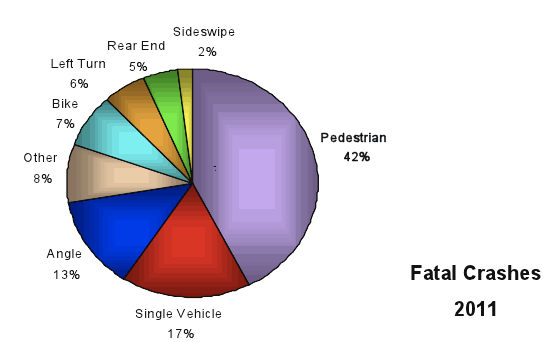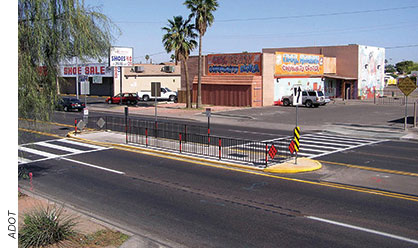Being a pedestrian in Phoenix is dangerous business. This is a place that comes by its reputation as a car-friendly city honestly. Phoenix pedestrians account for just 2 percent of collisions, but 42 percent of fatalities. That's the fourth-highest share of overall traffic deaths in the country, behind three cities with much more walking -- New York, Los Angeles, and Chicago.

But Phoenix city officials are beginning to reassess the position of pedestrians in the transportation hierarchy, taking steps to help protect the city's most vulnerable road users. The city's goals are lofty: a 10 percent reduction in pedestrian deaths each year, with zero by 2020.
The actual pedestrian safety ideas the city is pursuing, however, are not nearly as bold as what officials are doing in, say, Chicago, which has also set the goal of eliminating pedestrian deaths. Phoenix's pedestrian safety plans rely heavily on education -- both of pedestrians (especially the school-aged) and of motorists, not so much on changes to street design.
One of Phoenix's main tools to improve the safety of walking is a special style of traffic signal developed by engineers in neighboring Tucson. Phoenix is installing "High Intensity Activated Crosswalks," or HAWKs, as they're called, at some of the intersections that are most dangerous to pedestrians but might not warrant a full traffic signal, said Kerry Wilcoxon of Phoenix's Traffic Department. The HAWKs are activated when the pedestrian presses the signal, giving vehicles a yellow and then a red light and pedestrians a clear path through the roadway.
But downtown advocate Sean D. Sweat, a representative of the Central City Village Planning Commission, says the city could be doing a lot more.
"To me, HAWKs are a bandaid to a more fundamental problem with the street," he said. "I don’t think they -- our streets transportation department, our City Hall -- right now actually gets it. They talk the talk, but we’re not seeing it on the ground."

City officials acknowledge the current built environment is very challenging for pedestrians, and they have taken some steps to redesign streets for greater safety. Phoenix has installed a number of pedestrian islands for people walking across wide streets. Local officials have also completed a small number of road diets, adding bike lanes to arterial roads, and in some cases removing travel lanes. In addition, the city of Phoenix is preparing Complete Streets legislation, according to Wilcoxon.
"We’re trying to address pedestrian safety just like we address automobile safety," Wilcoxon said.
Still, Sweat was surprised and disappointed when recent streetscape projects, which entirely rebuilt some roads, failed to incorporate bike lanes, or parallel parking, which could shield pedestrians. Sweat says the city needs to start turning over vehicle lanes to cyclists to make the streets safer and less highway-like. But he says the powers that be in Phoenix are frustratingly conservative when it comes to transportation.
"Trying to get them to even consider bike lanes has totally fallen on deaf ears," he said. "All they do is talk about vehicular capacity. They have no stomach for considering in their capacity models bikes and pedestrians, and they have no stomach for actually inconveniencing the drivers whatsoever."
For the past eight years, Phoenix has participated in an FHWA program designed for cities that have high rates of pedestrian crashes: the Pedestrian Peer Exchange Group. City officials say this collaboration with other high-crash cities provided the impetus for their pedestrian safety efforts.





